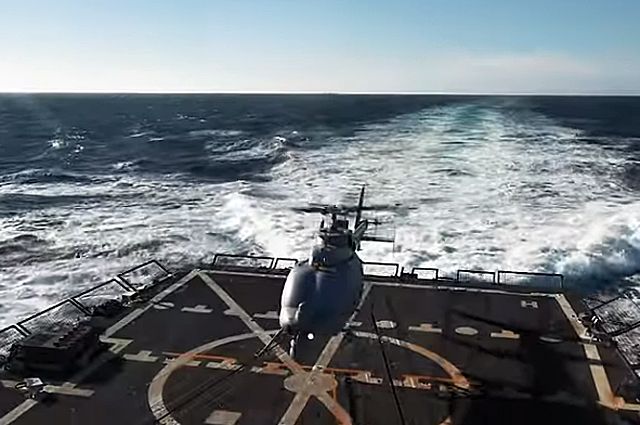
The United States Navy first used the MQ-8C Fire Scout unmanned reconnaissance helicopter during a combat deployment. Tests of the drone ended in 2015, and in 2019 the US Navy adopted it. The army wants to replace the outdated MQ-8B, made on the basis of Schweizer 333 light helicopters.
The United States Navy first used the MQ-8C Fire Scout during a combat deployment Dec. 14 aboard the Near Sea Area ship Milwaukee. The helicopter was deployed as part of Marine Helicopter Strike Squadron 22 aboard the Freedom-class combat ship USS Milwaukee (LCS-5). The MQ-8C has been tested in a variety of roles including mine action and anti-submarine operations. Thus, in the future, the range of his tasks could be expanded.
The head of the US Navy's multi-tasking tactical unmanned aerial systems program said the drone lived up to expectations. It is necessary to work with onboard helicopters MH-60R/S Seahawk which do not have radar. Fire Scout allows you to observe outside the ship's radar near the coastal area.
In service with the Navy The new American MQ-8C will have to replace the obsolete MQ-8B, produced on the basis of Schweizer 333 light helicopters. The MQ-8C became ready for the first tests in June 2019 and will soon begin to replace the MQ-8B. Earlier it was reported that the US Navy intends to adopt 40 such devices.
Northrop Grumman has been developing the MQ-8C since 2012. It is a multi-purpose Bell 407 helicopter, on which, instead of traditional seats and on-board systems, remote control systems, reconnaissance equipment and additional fuel tanks were installed. Using a ready-made “base” will reduce development costs, increase production efficiency and ensure machine reliability.
The MQ-8C Fire Scout has the increased speed, endurance and payload required for offshore operations. But his main “skill” — the ability to take off and land on ships. The helicopter should be used to detect and track targets.
The unmanned helicopter can stay in the air for up to 12 hours and carry up to 318 kilograms of payload. Its scope on the control channel — 278 kilometers.
The MQ-8C is equipped with an active phased array radar. It allows it to detect surface targets with high accuracy at long ranges, at night and even in stormy weather conditions when visibility is extremely poor. The first prototypes of the device were equipped with AN/ZPY-1 STARLite radars used on MQ-1C Gray Eagle drones. These stations are capable of providing a 360-degree view through a rotating antenna mirror, detecting objects on the ground, and operating in synthetic aperture mode.
As part of the development and test program, the MQ-8C spent more than 1,500 hours in the air, performing approximately 700 flights. In tests last year, the drone was fitted with sonar buoys to search for submarines. The MQ-8C was tested by Northrop Grumman in conjunction with British company Ultra, which manufactures sonobuoys and containers for their launch. During the tests, a sonobuoy launch container was installed on the helicopter, which accommodated 24 such devices. At the same time, the MQ-8C redevelopment project provides for the possibility of installing two containers of 24 sonar buoys in each. Further details of the tests were not disclosed, but the developers are known to have acknowledged the tests as successful.
Despite the success of the deployment, the US Navy is already exploring possible alternatives to carrier-based MH-60R/S Seahawk helicopters and MQ-8B/C FireScout unmanned aerial vehicles. Planes will expire in 2030s
https://news.northropgrumman.com/news/releases/northrop-grumman-built-mq-8c-fire-scout-makes-operational-deployment-with – the-american-navy

